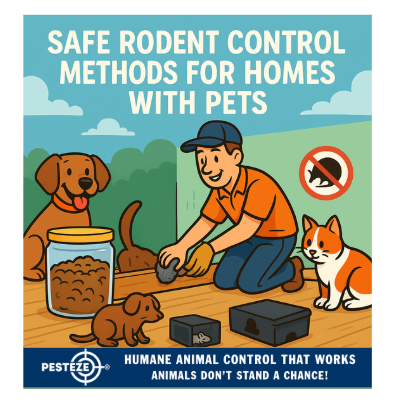SAFE RODENT CONTROL METHODS FOR HOMES WITH PETS

SAFE RODENT CONTROL METHODS FOR HOMES WITH PETS
SUMMARY
This guide gives pet-safe, practical strategies to prevent and remove rodents while protecting dogs, cats, and other companion animals. It emphasizes exclusion, sanitation, non-toxic traps, cautious use (or avoidance) of rodenticides, and when to call a professional.
FEATURES
-
Seal & Exclude: Block entry points with pet-safe materials.
-
Sanitation First: Remove food, water, and shelter that attract rodents.
-
Pet-Safe Trapping: Use live-capture or carefully placed snap traps in pet-proof enclosures.
-
Avoid Rodenticides When Possible: Strongly caution against poisons due to secondary poisoning risk.
-
Monitor & Follow Up: Use tamper-proof monitoring stations and frequent checks.
-
Call the Professionals: Use licensed pest control for heavy infestations or if pets are at risk.
GUIDE DESCRIPTION
When pets share your home, rodent control must balance effectiveness with safety. The most successful, least risky approach starts with prevention: make your home unattractive to mice and rats. Store pet food in sealed, rodent-proof containers, clean bowls after meals, secure garbage with latching lids, remove spilled bird seed, and eliminate clutter where rodents nest. Fix leaky pipes and remove standing water—rodents need water sources just like pets do.
Next, exclude rodents physically. Inspect the exterior for gaps around foundations, vents, doors, and utility lines. Use materials that rodents can’t chew through—steel wool packed into gaps and sealed with silicone or caulk, hardware cloth (1/4"–1/2") over vents, and metal flashing around vulnerable seams. Door sweeps and mesh over dryer vents are cheap, durable, and pet-safe solutions. Exclusion prevents infestations and reduces the need for active control measures that could endanger pets.
For active removal, prefer methods that keep pets safe. Live-capture box traps are an option for small problems—check them at least twice daily to minimize stress, wear gloves, and follow local rules about release (relocation is illegal in some areas). If you use lethal traps, choose high-quality snap traps placed inside tamper-resistant bait stations or enclosed boxes secured where pets cannot access them (behind appliances, in attics, in crawlspaces). Avoid glue boards and spring-loaded traps left in open areas—they catch non-target animals and cause prolonged suffering.
Rodenticides (poisons) present the highest risk to pets — both primary ingestion (pet eats the bait) and secondary poisoning (pet eats a poisoned rodent). If a professional recommends rodenticide, insist on tamper-resistant stations, baits formulated and placed to minimize pet access, and clear instructions for cleanup. In most pet households, consider alternatives first; if poisons are used, keep pets supervised and consult your veterinarian or local poison control immediately if you suspect exposure.
Monitoring and follow-up are crucial. Use snap-shut or live traps in pet-secure locations, check frequently, and document captures to assess whether additional exclusion or sanitation is needed. For large infestations, suspicious droppings in food prep areas, or signs of structural damage, hire a licensed pest-control company experienced with pet-safe Integrated Pest Management (IPM). They can implement targeted measures, advise on legal issues around relocation, and coordinate cleanup (rodent urine and droppings can carry zoonotic pathogens).
Finally, be ready for emergencies: keep your veterinarian’s number and your local poison-control hotline handy. Quick veterinary attention radically improves outcomes if a pet ingests bait or a poisoned rodent. With prevention, careful trapping, and professional help when needed, you can solve rodent problems without putting your companions at risk.
- Saneeth Thota


Comments 0